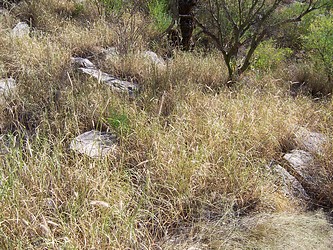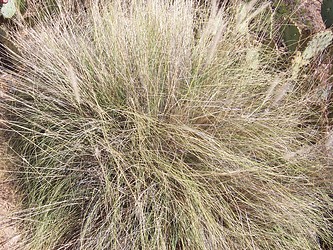

Buffelgrass, Cenchrus ciliaris, in Sabino Canyon, Tucson, © 2005 aurelius1
Introduction
Buffelgrass is an invasive species that is hurting our beautiful Sonoran Desert. An invasive species is one that is non-native to the area it inhabits and that uses up resources that are necessary for native species to survive. Buffelgrass has several charcteristics that lead to it being not only a nuisance, but also a danger to our desert environment. We need to eliminate it in our beautiful desert country before it leads to the destruction of many of our important native plants.
Buffelgrass is very easy to spot because of its physical characteristics. It is yellow-brown in color during the summer and green after the monsoon season in July and August. However, buffelgrass is immune to droughts and can survive long periods of time without water. It is a very tall grass that chokes out native grasses. During the summer months when buffelgrass is very dry, it burns very quickly. The fact that buffelgrass burns so rapidly makes it especially dangerous in wildfire season. Buffelgrass also spreads to different locations very easily because the seeds get blown across large areas during wind storms. The only effective way to get rid of buffel grass is to pull the grass by hand, making sure that the roots are removed with the grass. Poisons do not effectively get rid of the buffel grass which is another reason why buffelgrass is so commonly found. These are some of the important characteristics of the commonly found buffelgrass.


Buffelgrass, Cenchrus ciliaris, in Sabino Canyon, Tucson, © 2005 aurelius1
Conclusion
Residents of Pima County are very fortunate to be able to take advantage of such a beautiful desert landscape everywhere around them; however, this landscape is being harmed by the ever-increasing population of buffelgrass. Buffelgrass is very hard to eradicate and the only way to do so is by hand. Since this is the only way to exterminate this invasive species we must get people to help and volunteer to aid in the process of removing this annoying and dangerous grass.
Information on the Internet
- Buffelgrass (Pennisetum ciliare) Part of a Sonoran Desert Museum initiatve that shows how citizens are combatting invasive species.



 Go to quick links
Go to quick search
Go to navigation for this section of the ToL site
Go to detailed links for the ToL site
Go to quick links
Go to quick search
Go to navigation for this section of the ToL site
Go to detailed links for the ToL site